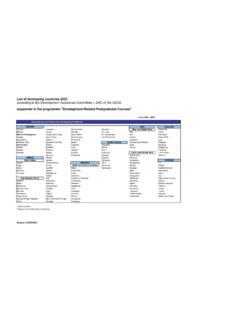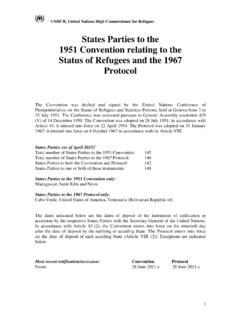Transcription of EDUCATIONAL DEVELOPMENTS IN THE BRITISH WEST …
1 Part 4: Higher Education, Lifelong Learning and Social Inclusion 347 CHAD O. COATES EDUCATIONAL DEVELOPMENTS IN THE BRITISH WEST INDIES: A HISTORICAL OVERVIEW Abstract Formal education within the English-speaking Caribbean Community (CARICOM) may be traced back to the establishment of Codrington grammar school in Barbados in 1743. After more than two centuries of BRITISH colonial rule the EDUCATIONAL systems within CARICOM states continue to reflect the academic traditions of their former colonizer. Prior to emancipation in 1838, the notion of providing education for the African slaves met strong opposition from plantation owners, despite the efforts of many Christian missionaries seeking to provide religious education to convert enslaved-Africans to Christianity.
2 During the post-emancipation period, the education of ex-slaves within the BRITISH West Indies became one the central issues of the day. Religious groups including the Anglicans, Baptists, Catholics, Methodists, Mico Charity, Presbyterians, and Wesleyans, together with financial support from the imperial government and the Negro Education Grant, drove and shaped the development of education at all levels of the BRITISH West Indian society. The purpose of this paper is to present a brief historical overview of some key DEVELOPMENTS in formal education within the English-speaking Caribbean during the period following emancipation.
3 Introduction The Anglophone Caribbean Community (CARICOM) consists of a grouping of democratic states located in the Caribbean Sea that have a shared history of over 300 years of BRITISH colonization (UNESCO, 2001). CARICOM states are characterized by similarities in heritage, socio-cultural norms and values, as well as political, and EDUCATIONAL systems. For example, the education systems throughout the Commonwealth Caribbean are based on the BRITISH model of formal education (Peters, 2001). The region is geographically composed of ten independent small island states: Antigua and Barbuda, Bahamas, Barbados, Dominica, Grenada, Jamaica, St Kitts and Nevis, St Lucia, St vincent and the grenadines , and Trinidad and Tobago; two independent territories located on the main land of South America: Belize and Guyana; and four BRITISH dependencies: Anguilla, BRITISH Virgin Islands, Cayman Islands, and the Turks and Caicos Islands (Roberts, 2003).
4 Shortly after World War II, the process of decolonization began to take place in the West Indies. Two key factors impacting the decolonization process included insufficient finance on the part of the BRITISH Crown following the war, and a growing aspiration for independence among individual states within the Caribbean (Millette, 2004). In August of 1962, the two largest BRITISH colonies, Jamaica and Trinidad and Tobago, gained their independence (Cox-Alomar, 2004; CARICOM, 2005). Many of the remaining BRITISH colonies gained independence shortly thereafter during the late 1960s and into the early 1980s (Millette, 2004; CARICOM, 2005).
5 During the decolonization period the demographic composition of the student population within the BRITISH West Indian education system changed rapidly as EDUCATIONAL DEVELOPMENTS in the BRITISH West Indies: A Historical Overview 348 many Whites chose to return to Britain. However, the BRITISH EDUCATIONAL structures continue to be an essential component of many of the EDUCATIONAL systems within the region. Within CARICOM, education plays an integral role in regional development. Historically, education has served the region as a catalyst for productive endeavors that support the creation, acquisition, and dissemination of the knowledge and skills necessary to stimulate and drive Caribbean economies (Leo-Rhynie, 2005).
6 At the higher levels, education within the region serves to prepare graduates for taking on leadership roles in government, industry and commerce, research, strategic planning, and problem solving. Early DEVELOPMENTS in formal education The BRITISH model of formal education within the Caribbean dates back to the 1834 Emancipation Act, which provided the first opportunity for mass schooling within the region for a population comprised largely of ex-slaves (Hunte, 1976). The Emancipation Act provided for the education of the ex-slaves within the BRITISH colonies and was backed by financial support from the Imperial Government and through the Negro Education Grant (Hunte, 1976).
7 The Negro Education Grant was endowed by an inheritance left by Lady Mico in 1690. Lady Mico had willed her wealth to her nephew with the pre-condition that he married one of his cousins. Alternatively, the inheritance would be used for the redemption of Christians captured and enslaved by Barbery pirates (Gordon, 1963, p. 23). The nephew in question never married his cousin, and in 1834, Thomas Fowell Buxton and other abolitionists convincingly argued that the Mico inheritance should be used for the purpose of Negro Education.
8 During the first two years, the Negro Education Grant was issued to religious groups solely for constructing schools. The Imperial Government contributed to paying two-thirds of the building cost while the religious groups contributed one-third. During the time of the Negro Education Grant, the Mico Charity had provided more EDUCATIONAL funding than any other religious group, and had opened four Normal Schools for the training of native teachers. Prior to emancipation, opportunities for the education of African slaves within the BRITISH West Indies were practically non-existent; and where they did exist, were met with harsh opposition from plantation and slave owners (Gordon, 1963; Phillippo, 1843).
9 The majority of the White population, who could afford it, sent their sons to be educated in England as there was no equivalent of a good English grammar school education to be had in the West Indies (Gordon, 1963, p. 15). For less wealthy Whites, the demand for a grammar school education was met in part by planters and merchants, primarily in Jamaica and Barbados, who endowed local schools on these islands (Gordon, 1963). The most noteworthy donor was Christopher Codrington of Barbados, who bequeathed his estate to provide fiscal support for the Codrington grammar school for boys in Barbados.
10 The school was founded in 1743 and opened in 1745 (Braithewaite, 1958). At the start of the nineteenth century, the BRITISH Government provided new subsidies for West Indian education as part of a system of imperial grants. Following emancipation in 1838, there were rapid increases in EDUCATIONAL enrollment. There was also an increase in the number of elementary, and subsequently, secondary schools (Gordon, 1963; Bacchus, 1994). For example, prior to 1823 there were fewer than three schools in Jamaica that were dedicated solely to Chad O.













